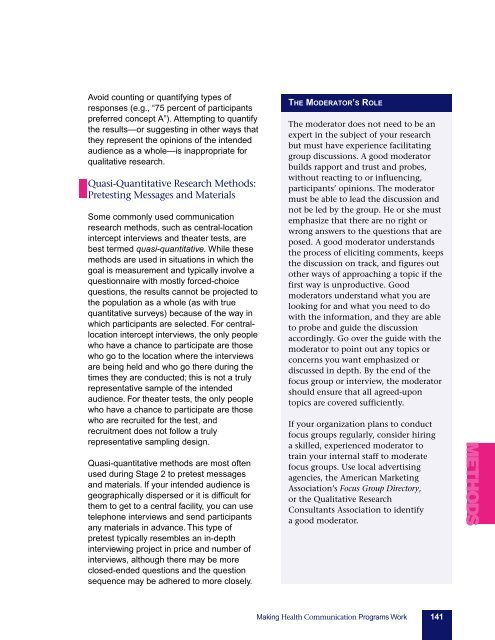pink-book
pink-book
pink-book
Create successful ePaper yourself
Turn your PDF publications into a flip-book with our unique Google optimized e-Paper software.
Avoid counting or quantifying types of<br />
responses (e.g., “75 percent of participants<br />
preferred concept A”). Attempting to quantify<br />
the results—or suggesting in other ways that<br />
they represent the opinions of the intended<br />
audience as a whole—is inappropriate for<br />
qualitative research.<br />
Quasi-Quantitative Research Methods:<br />
Pretesting Messages and Materials<br />
Some commonly used communication<br />
research methods, such as central-location<br />
intercept interviews and theater tests, are<br />
best termed quasi-quantitative. While these<br />
methods are used in situations in which the<br />
goal is measurement and typically involve a<br />
questionnaire with mostly forced-choice<br />
questions, the results cannot be projected to<br />
the population as a whole (as with true<br />
quantitative surveys) because of the way in<br />
which participants are selected. For centrallocation<br />
intercept interviews, the only people<br />
who have a chance to participate are those<br />
who go to the location where the interviews<br />
are being held and who go there during the<br />
times they are conducted; this is not a truly<br />
representative sample of the intended<br />
audience. For theater tests, the only people<br />
who have a chance to participate are those<br />
who are recruited for the test, and<br />
recruitment does not follow a truly<br />
representative sampling design.<br />
Quasi-quantitative methods are most often<br />
used during Stage 2 to pretest messages<br />
and materials. If your intended audience is<br />
geographically dispersed or it is difficult for<br />
them to get to a central facility, you can use<br />
telephone interviews and send participants<br />
any materials in advance. This type of<br />
pretest typically resembles an in-depth<br />
interviewing project in price and number of<br />
interviews, although there may be more<br />
closed-ended questions and the question<br />
sequence may be adhered to more closely.<br />
THE MODERATOR’S ROLE<br />
The moderator does not need to be an<br />
expert in the subject of your research<br />
but must have experience facilitating<br />
group discussions. A good moderator<br />
builds rapport and trust and probes,<br />
without reacting to or influencing,<br />
participants’ opinions. The moderator<br />
must be able to lead the discussion and<br />
not be led by the group. He or she must<br />
emphasize that there are no right or<br />
wrong answers to the questions that are<br />
posed. A good moderator understands<br />
the process of eliciting comments, keeps<br />
the discussion on track, and figures out<br />
other ways of approaching a topic if the<br />
first way is unproductive. Good<br />
moderators understand what you are<br />
looking for and what you need to do<br />
with the information, and they are able<br />
to probe and guide the discussion<br />
accordingly. Go over the guide with the<br />
moderator to point out any topics or<br />
concerns you want emphasized or<br />
discussed in depth. By the end of the<br />
focus group or interview, the moderator<br />
should ensure that all agreed-upon<br />
topics are covered sufficiently.<br />
If your organization plans to conduct<br />
focus groups regularly, consider hiring<br />
a skilled, experienced moderator to<br />
train your internal staff to moderate<br />
focus groups. Use local advertising<br />
agencies, the American Marketing<br />
Association’s Focus Group Directory,<br />
or the Qualitative Research<br />
Consultants Association to identify<br />
a good moderator.<br />
METHODS<br />
Making Health Communication Programs Work 141


